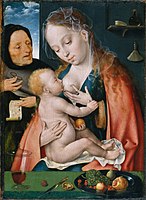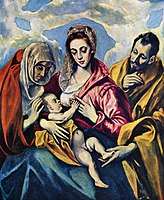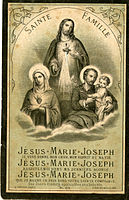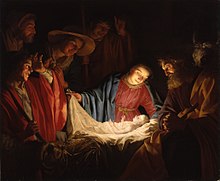Holy Family

The Holy Family consists of the Child Jesus, the Virgin Mary, and Saint Joseph. The subject became popular in art from the 1490s on,[1] but veneration of the Holy Family was formally begun in the 17th century by Saint François de Laval, the first bishop of New France, who founded a confraternity.
The Feast of the Holy Family is a liturgical celebration in the Catholic Church, as well as in many Lutheran and Anglican churches, in honour of Jesus, His mother, and His foster father, Saint Joseph, as a family;[2] it has been observed since 1921 when it was inserted by Pope Benedict XV.[3] The primary purpose of this feast is to present the Holy Family as a model for Christian families.[4] There are many churches dedicated to the Holy Family.[5]
The Feast of the Holy Family falls within the season of Christmastide and in the General Roman Calendar since 1969, it is held on the Sunday between Christmas Day and January 1; if both are Sundays, the Feast of the Holy Family is celebrated on December 30th.[2] For those communities keeping the General Roman Calendar of 1960 or the General Roman Calendar of 1954, the Feast is kept on the Sunday after Epiphany Day, which occurs on January 6th. Those two traditional calendars only differ in years when the Sunday after January 6th is January 13th. In such a case the General Roman Calendar of 1960 keeps the Holy Family on the 13th whereas the General Roman Calendar of 1954 moves the feast up to January 12th.

The Gospels speak little of the life of the Holy Family in the years before Jesus’ public ministry.[6] Matthew and Luke narrate the episodes from this period of Christ's life, namely his circumcision and later Presentation, the flight to Egypt, the return to Nazareth, and the Finding in the Temple.[4] Joseph and Mary were apparently observant Jews, as Luke narrates that they brought Jesus with them on the annual pilgrimage to Jerusalem with other Jewish families.
Veneration[]
The Feast of the Holy Family is a liturgical celebration in the Catholic Church, as well as in many Lutheran and Anglican churches, in honour of Jesus of Nazareth, his mother, the Blessed Virgin Mary, and his foster father, Saint Joseph, as a family.[2][3] The primary purpose of this feast is to present the Holy Family as a model for Christian families.[4]
From the 17th century, the feast has been celebrated at a local and regional level and at that level was promoted by Pope Leo XIII. In 1921, Pope Benedict XV made it part of the General Roman Calendar and set on the Sunday within the Octave of the Epiphany (cf. Epiphanytide); that is to say, on the Sunday between January 7 through January 13, all inclusive (see General Roman Calendar of 1954).[7][8]
In the General Roman Calendar of 1954, the Sunday within the Octave of Christmas was in fact celebrated on the Sunday only if it fell on 29, 30 or 31 December, since it gave way to the higher-ranked feasts of Saint Stephen, Saint John the Apostle and the Holy Innocents; otherwise, it was transferred to December 30, and if the feast of Saint Thomas Becket, one of the most popular additions to the calendar in the Middle Ages, was celebrated in double rite (as it was universally after 1907), then it too took precedence over this Sunday, until the 1911 reforms where double feasts no longer did so automatically. The 1962 Roman Missal, whose use is still authorized per the 2007 motu proprio Summorum Pontificum, follows the General Roman Calendar of 1960, which ranks the Sunday within the Octave of Christmas as higher than these saints and keeps the Feast of the Holy Family on the Sunday after Epiphany.
The 1969 revision of the General Roman Calendar moved the celebration of the Holy Family to the Sunday within the Octave of Christmas, that is, the Sunday between Christmas Day and New Year's Day (both exclusive), or if both Christmas Day and the Solemnity of Mary, Mother of God are Sundays, on 30 December, which is always a Friday in such years. When not celebrated on a Sunday, it is not a holy day of obligation.[9] In the General Roman Calendar of 1969 the Feast of the Holy Family outranks the various saints whose feastdays fall during the Octave of Christmas, namely Saint Stephen, Saint John the Apostle and the Holy Innocents, in a departure from the General Roman Calendar of 1954.
In art[]

The Holy Family became a subject popular in art in the early 16th century, in both Italian Renaissance painting and Dutch and Flemish Renaissance painting. The popularity of the subject was associated with an increased interest in, and devotion to, Saint Joseph. In the later Middle Ages he had become something of a comic figure, whose age was emphasized, and was often shown asleep in Nativity scenes. In the 15th century confraternities dedicated to Joseph were part of revived devotional interest, who is now at least awake, and often shown taking an active role in parenting.[10]
Many early Holy Family compositions are either Nativity scenes or the Rest on the Flight into Egypt with the removal of other event-specific elements, such as the ox and ass of the Nativity, to concentrate on the three main figures for devotional images, mostly intended for wealthy homes. Alternatively many compositions clearly derive from a Madonna and Child, with a Saint Joseph added. Often the figures were shown close-up, filling much of the picture space.[11]
Related variants add Jesus's slightly older cousin, Saint John the Baptist, and often his mother Saint Elizabeth; but Joseph is often absent in these, removing them from the usual definition of a Holy Family. It was thought that the Holy Family stayed with Elizabeth on their return from Egypt, and these pictures tend to show the children older than newborns. The extended family of Jesus, already popular as a subject in art, is called the Holy Kinship; this might include up to twenty figures.[12]
Italy[]
The Parte Guelfa Holy Family by Luca Signorelli dates from about 1490. Mantegna appears to have invented the very tightly focused group in the late 1490s, painting several variants with John the Baptist and his mother, such as one now in Dresden. Some of these have standing or vertical infants, mostly toddlers rather than new-borns.[13]
By the High Renaissance many Italian paintings had a horizontal format. The subject was popular with Antonio da Correggio (examples are in Pavia, Orléans, the Royal Collection, Los Angeles and Mantua), and Domenico Beccafumi (examples in Munich, Galleria Palatina, Florence and also the Uffizi there). Michelangelo's tempera rendition (c. 1506) hangs in the Uffizi in Florence, Italy.[14] A Holy Family by Giulio Romano is in the Prado, with another at the Getty Center in Los Angeles, California.[15]

Lorenzo Lotto also painted the subject several times, tending to add angels and saints from later periods, to produce versions of a sacra conversazione. Examples are Holy Family with Saint Catherine of Alexandria, Holy Family with St Jerome and St Anne, as well as one in the Louvre with the families of Jesus and John the Baptist.
Northern Europe[]
North of the Alps, prints from the 1490s by Albrecht Dürer probably preceded any paintings. An early northern painting is by the Master of the Saint Bartholomew Altarpiece around 1500, where the composition has clearly been freshly imagined. By contrast, the Holy Family by the Dutch artist Joos van Cleve of c.1512 in the New York Metropolitan Museum of Art,[16] essentially reduces Jan van Eyck's Lucca Madonna to a close-up with still life details, and adds Saint Joseph over the Virgin's shoulder.[17]
Gallery[]

The Holy Family with the Dragonfly, Albrecht Dürer, 1495, engraving; Joseph is asleep.

Joos van Cleve, Metropolitan Museum of Art, c. 1512, adapting a van Eyck Madonna with Joseph added.

The Holy Family of Francis I, by Raphael (and assistants), 1518

Holy Family with the Family of St John the Baptist, c. 1536, Lorenzo Lotto, Louvre

El Greco, 1595, one of a number of versions

French holy card, 1890.[18]
Patronages and customs[]
| Part of a series on |
| Josephology of the Catholic Church |
|---|
 |
| General articles |
|
| Prayers and devotions |
| Organisations |
|
| Papal documents |
|
|
The members of the Holy Family are the patrons of the Congregation of Holy Cross. The Holy Cross Sisters are dedicated to the Immaculate Heart of Mary, the Holy Cross Brothers to St. Joseph, and the Priests of Holy Cross to the Sacred Heart. The Sons of the Holy Family is another religious congregation devoted to the Holy Family.
The Cathedral of the Holy Family of Nazareth is the see of the Diocese of Tulsa in Oklahoma.[19]
A pious practice among Christians, especially Catholics, is to write "✝ J.M.J. ✝" often flanked by two Christian crosses at the top of letters, cards, documents and personal notes as a reference to Jesus, Mary, and Joseph as the Holy Family.[20] Where it is written, "✝ J.M.J. ✝" is an "appeal for the blessing of the Holy Family."[21]
See also[]
- Category:Paintings of the Holy Family
- Brothers of Jesus
- Chronological list of saints in the 1st century
- Chronology of Jesus
- Finding in the Temple
- Flight into Egypt
- Holy Kinship
- Sisters of the Holy Family of Nazareth
Notes[]
- ^ Ainsworth, 122
- ^ Jump up to: a b c Driver, Cory (27 December 2019). "What are the 12 days of Christmas?". Living Lutheran. Retrieved 26 March 2021.
- ^ Jump up to: a b Pfatteicher, Philip H. (1990). Commentary on the Lutheran Book of Worship: Lutheran Liturgy in Its Ecumenical Context. Augsburg Fortress. p. 215. ISBN 978-0-8006-0392-2.
- ^ Jump up to: a b c "Strasser O.S.B., Bernard. With Christ Through the Year". Archived from the original on 2016-03-04. Retrieved 2014-01-02.
- ^ Rooms, Nigel (2003). Uninished churches. Third Way. p. 26.
- ^ Martin, James. "The Holy Family", Catholic Update
- ^ Encyclopædia Britannica: Feast of the Holy Family
- ^ Ss. Cosmas and Damian Roman Catholic Parish: Feast of the Holy Family of Jesus, Mary and Joseph
- ^ It is not among the ten feasts listed in canon 1247 of the 1917 Code of Canon Law, and canon 1246 of the 1983 Code as holy days of obligation. It would be a day of obligatory Mass attendance in years only when it falls on a Sunday by virtue of it being a Sunday, not by virtue of it being the Feast of the Holy Family
- ^ Ainsworth, 122
- ^ Hall, 335
- ^ Hall, 335
- ^ The Holy Family with Saint John the Baptist, Andrea Mantegna, National Gallery]
- ^ ""The Holy Family", Art in the Bible". Artbible.info. Retrieved 2019-01-15.
- ^ "The Holy Family", The J. Paul Getty Museum Archived 2014-01-02 at the Wayback Machine
- ^ ""The Holy Family", New York Metropolitan Museum of Art". Metmuseum.org. Retrieved 2019-01-15.
- ^ Snyder, James. Northern Renaissance Art, 1985, p. 417, Harry N. Abrams, ISBN 0136235964
- ^ University of Dayton Libraries
- ^ "Cathedral of the Holy Family of Nazareth". Archived from the original on 2013-10-30. Retrieved 2014-01-02.
- ^ Perrotta, Louise Bourassa (March 2000). Saint Joseph. Our Sunday Visitor Publishing. p. 149. ISBN 978-0-87973-573-9.
- ^ Manney, Jim (1 November 2017). Ignatian Spirituality A to Z. Loyola Press. ISBN 978-0-8294-4599-2.
References[]
- Ainsworth, Maryan Wynn (ed), Man, Myth, and Sensual Pleasures: Jan Gossart's Renaissance : the Complete Works, 2010, Metropolitan Museum of Art, ISBN 1588393984 9781588393982, fully online
- Hall, James, Hall's Dictionary of Subjects and Symbols in Art, 1996 (2nd edn.), John Murray, ISBN 0719541476
| Wikimedia Commons has media related to Holy Family. |
External links[]
- Family of Jesus
- Articles about multiple people in the Bible
- Brothers of Jesus
- Catholic holy days
- Christian terminology
- Mary, mother of Jesus
- Groups of Roman Catholic saints
- December observances
- Saint Joseph (husband of Mary)








